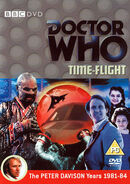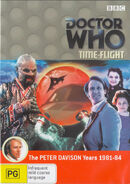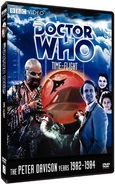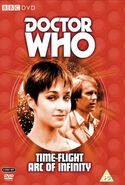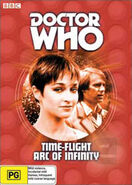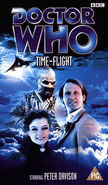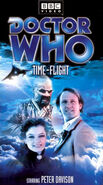Time-Flight was the seventh and final story of season 19 of Doctor Who.
For those interested in viewing statistics, it's a highly significant story, because different surveys of audience reaction have produced widely varying results. The most statistically valid of these measures — the actual television ratings — show that episode one was the most successful episode in John Nathan-Turner's entire producership. The 26th-most-watched episode of British television in the week of initial transmission, it was the only time he cracked the top 30. However, the story also shed about two million viewers from beginning to end.
Fan opinion — which, of course, is never the subject of truly valid statistical investigation — has changed dramatically over the years. Those who responded to DWM 69's season 19 poll held it in reasonably high regard, placing it as the fourth-best serial of the year, ahead of Castrovalva, Four to Doomsday and Kinda. Decades later, those fans responding to DWM 413's "Mighty 200" poll in 2009 cited it as the 196th of the 200 stories that were then produced. Similarly, fan response to the "first 50 years" poll in DWM 474 in 2014 cited it as the 237th out of the 241 stories up to that point in time. A part of the explanation for this massive shift in negative momentum may be that fan leaders such as Paul Cornell and David J. Howe savaged the story in references works like The Discontinuity Guide and The Television Companion, whose influence multiplied when BBCi, and later BBC Online, incorporated those opinions into the official Doctor Who website. Thus people skimming the official site in the 2000s and 2010s could well believe that opinion of the BBC runs along the lines of, "Somebody, somewhere should have thrown this script in the bin the moment it had Concorde crash landing in Jurassic England..."
Narratively, the story contained what appeared, at the time of transmission, to be the final appearances of both Adric and Tegan. The former appeared as an apparition to satisfy Matthew Waterhouse's contract. Meanwhile, Tegan was left behind at Heathrow Airport at the conclusion of the episode. This appeared to end her story, since many stories that year had begun with a gag about trying to get her back to Heathrow. However, because modern viewers — even those who have never seen Time-Flight — almost certainly know that this is not the character's final outing, the episode four cliffhanger is now robbed of much of its power.
Synopsis
While investigating a vanishing Concorde at Heathrow Airport, the Doctor and his companions are thrown millions of years back in time, when a mysterious alien called Kalid is trying to control the ancient powers of the Xeraphin.
Plot
Part one
On a regular flight from New York to London, a Concorde designated Golf Victor Foxtrot (GVF) is nearing Heathrow Airport when its signal breaks up. All trace of the aircraft is lost — the Concorde has disappeared. Arriving at Heathrow shortly afterward, still grieving for Adric, the Fifth Doctor, Nyssa and Tegan are enlisted by Department C19 to help in the investigation of the missing craft.
Aboard the Concorde
The trio board a similar Concorde, Golf Alpha Charlie, and follow the same flight path to try to discover the cause of the disappearing Concorde. The TARDIS is stowed on board. Stapley, the Concorde's captain, and his senior crew welcome them aboard. The Doctor finds traces of disturbance. Although they arrive safely at Heathrow, they find they have travelled a hundred forty million years into the past.
The crew believe they have landed in modern Heathrow. The Doctor and Nyssa urge them to challenge this perception and realise the reality of the empty landscape. It is distorted by huge amounts of psychokinetic energy. They spy Victor-Foxtrot on the empty plain. Beyond it is an impressive citadel in the far distance and the remains of an alien spacecraft.
The Doctor and his friends find the crew and passengers of the first Concorde. They are moving his TARDIS toward the Citadel on the instructions of an alien entity. Everyone is totally immersed in the illusion of a modern Heathrow - all, that is, save one passenger, Professor Hayter. He has resisted the illusion. Andrew Bilton and Roger Scobie, Stapley's flight crew, succumb to the illusion. They head for the Citadel with the TARDIS and the other confused passengers. Their progress is marshalled by the Plasmatons - blobs of protein from the atmosphere, assembled from random particles that are held together by the same kinetic energy.
Part two
The face behind Kalid
The force in charge of this strange domain is Kalid. He seems to be an oriental mystic. He uses a glowing green globe to control psychokinetic energy and shape the prehistoric landscape of Earth.
Nyssa has a particular empathy with this energy. She starts getting visions and hearing voices. They are unwelcome to Kalid. He tries to cut her off from the others with a protoplasmic shield. Tegan stays with Nyssa while the Doctor ventures on to the Citadel with Hayter and Stapley. There they find the crew of Victor-Foxtrot, blindly trying to remove the walls of a sealed chamber.
Stapley and Hayter try to free the others from the mental illusion. The Doctor heads to the Citadel and meets Kalid. The green-tinged magician has evidently brought a slave force to prehistoric Earth. He taps into the psychokinetic powers of the place and uses the energies to menace Hayter, Stapley and the others to try to secure the Doctor’s cooperation in entering his TARDIS.
This exertion has broken Kalid’s mental hold over the plasmatons around Nyssa. They disperse. Nyssa and Tegan follow the former’s instincts. They enter the Citadel and quickly enter the chamber that has been closed to Kalid and the mentally deluded passengers. Nyssa throws an artefact into the centre of a tank-like structure in the centre of the sealed room. The results are immense. Kalid’s mental channelling is interrupted and he collapses in agony. His disguise falls away to reveal the Master.
Part three
The Xeraphin
The Master is trapped in this time zone. He is looking for a way out and needs a new source of power for his TARDIS. The power in the closed chamber could be it, but the passengers are taking too long to get to it. He forces the Doctor to give him the key to the TARDIS and steals the craft to try to enter the chamber another way. The Doctor and Hayter rush to the chamber to reach it first. As they do, the Concorde passengers finally break through the wall.
Inside, the Doctor and Hayter are reunited with Nyssa and Tegan. The sarcophagus at its centre holds a being of immense power. However, it has a split personality . It has let itself be used by the Master and Nyssa. Nearby are small shrunken bodies. The Doctor identifies them as the Xeraphin, a race of ancient beings believed destroyed during the Vardon-Kosnax War.
Instead, the entire race seems to have transformed itself into a single gestalt intelligence in the tank. It has phenomenal psychic abilities. Hayter sacrifices himself to the creature to let it communicate. He is absorbed into the entity.
The Xeraphin manifest as Anithon. It explains the entity came to Earth to escape the war. It came in the crashed spaceship on the plains. The Xeraphin were so harmed by radiation that they shed their bodies and became a single entity. The Xeraphin built the Citadel and planned to re-emerge from the sarcophagus once the radiation danger was over. The Master’s arrival disturbed the balance. The gestalt has developed a split personality of good and evil. Each side competes for their tremendous power, but yearns to become a proper species once again.
The Doctor has left the coordinate override switched on, and Captain Stapley has performed sabotage. The TARDIS won't take the Master into the central chamber. His next gambit is to build an induction loop to remotely access the sarcophagus and exert his will over it. The bad Xeraphin responds. Within moments the sarcophagus is in the Master’s TARDIS, a new power source.
Part four
The Master tries to flee in his ship, with those passengers still deluded with him as slaves. He leaves the Doctor and his friends stranded. However, due to the sabotage by the Captain, the Master cannot leave prehistoric Earth. After some chaffering over missing parts, the Doctor has all the passengers released and some parts taken from his own TARDIS. In return, the Master gets a new temporal limiter.
Everyone leaves prehistoric Earth. The second Concorde is made serviceable. It carries Stapley, his crew and the passengers from the other Concorde to Heathrow. The Doctor reverses the track of the time contour and brings the plane back to Heathrow with his TARDIS. The Doctor programmed the temporal limiter he gave the Master to arrive after he did. When the Master tries to land, the Doctor's TARDIS is already in the spot. He bounces the Master's TARDIS away. The evil Time Lord is sent to modern-day Xeriphas, where the Doctor hopes the Xeraphin will exact their revenge.
In a rush to leave, the Doctor and Nyssa head off in his TARDIS. They assume that now Tegan is back in her beloved Heathrow she will be happy to stay. Her sorrow as she sees the TARDIS dematerialise tells a different story.
Cast
- The Doctor - Peter Davison
- Nyssa - Sarah Sutton
- Tegan Jovanka - Janet Fielding
- The Tremas Master - Leon Ny Taiy/Anthony Ainley
- Professor Hayter - Nigel Stock
- Captain Stapley - Richard Easton
- Andrew Bilton - Michael Cashman
- Roger Scobie - Keith Drinkel
- Adric - Matthew Waterhouse
- Andrews - Peter Cellier
- Angela Clifford - Judith Byfield
- Anithon - Hugh Hayes
- Captain Urquhart - John Flint
- Horton - Peter Dahlsen
- Sheard - Brian McDermott
- Zarak - André Winterton
Production Crew
- Assistant Floor Manager - Lynn Richards
- Costumes - Amy Roberts
- Designer - Richard McManan-Smith
- Film Cameraman - Peter Chapman
- Film Editor - Mike Houghton
- Incidental Music - Roger Limb
- Make-Up - Dorka Nieradzik
- Production Assistant - Joan Elliott
- Production Associate - Angela Smith
- Special Sounds - Dick Mills
- Studio Lighting - Eric Wallis
- Studio Sound - Martin Ridout
- Visual Effects - Peter Logan
- Script Editor - Eric Saward
- Writer - Peter Grimwade
- Producer - John Nathan-Turner
- Director - Ron Jones
References
Cricket
- Time-Flight is a serial with several cricketing references. The Doctor's suggestion for how to get over the death of Adric involves going to The Great Exhibition of 1851 to watch some cricket legends play. He says he wants to see a few overs with Wisden and Pilch. At the end of the story, he claims to have hit a straight six into the pavilion by putting his TARDIS in the space where the Master's was materialising, forcing the Master to go back into the time vortex.
Individuals
- The Doctor mentions Varsh in relation to Adric's death.
- Sir John Sudbury is the Doctor's contact within UNIT's department C19.
- When Nyssa and Tegan try to reach the sanctum, images of Adric, the Melkur and a Terileptil appear in order to dissuade them from going on any further.
- Dave Culshaw is a flight attendant on Golf Victor Foxtrot.
Organisations
- The Doctor mentions UNIT. He name drops Brigadier Lethbridge-Stewart and wonders if he's a general by now.
TARDIS
- The Master's TARDIS has a working chameleon circuit, but its dynormorphic generator has been exhausted, leaving him stranded on prehistoric Earth where he has made a deal with the Xeraphin.
- The TARDIS interior can be levelled with reference to its exterior doorway. Nyssa says that she wishes they had "known about that when we were on Castrovalva".
Time travel
- Tegan and Nyssa ask the Doctor to turn back in time and save Adric's life. The Doctor says he can't.
- The Master generates a time contour to capture the Concorde.
Vehicles
- Golf Victor Foxtrot (the callsign of the first Concorde) is left behind on prehistoric Earth.
Story notes
- Working titles for this story were Zanadin and Xeraphin.
- British Airways were given a copy of the script before filming. They asked for changes to parts of the story that could be considered detrimental to the company, including one line where a flight attendant refers to the passengers as "punters". (DCOM: Time-Flight)
- This story is perhaps the only evidence of product placement throughout the whole of Doctor Who. Time-Flight was the first television story allowed to film at Heathrow Airport and the first to be allowed to film in an actual Concorde aircraft.
- Anthony Ainley is credited as 'Leon Ny Taiy' in part one's credits to disguise the fact that Kalid was actually the Master. 'Leon Ny Taiy' is an anagram of 'Tony Ainley'.
- Nigel Stock (Professor Hayter) is credited as 'Hayter' in Radio Times.
- The story follows on directly from Earthshock, at the conclusion of which companion Adric was killed aboard a space freighter which crashed into the Earth. At the beginning of this story, Nyssa and Tegan plead with the Doctor to go back and save him, but the Doctor refuses on the grounds that, even with the TARDIS, there are laws of time that cannot be broken. In part two, Waterhouse makes a cameo appearance as an apparition version of Adric. Waterhouse stated in an interview it was a good point to leave, as Time-Flight "was a terrible story".
- When the TARDIS first lands in the terminal building at Heathrow, a woman announces over the speaker system that Air Australia apologises for the delay of one of its flights. At the end of the story, when Tegan is walking through the terminal, the same woman announces that the Air Australia flight is ready for boarding.
Ratings
- Part one - 10.1 million viewers
- Part two - 8.5 million viewers
- Part three - 9.1 million viewers
- Part four - 8.3 million viewers
Part one marked the last time the classic series exceeded 10 million viewers. By its final season, viewership would have dropped to the 3-4 million range. Discounting the 1996 TV movie, a rating exceeding 10 million viewers would not be achieved again until Rose.
Filming locations
- Heathrow Airport, Hounslow, Middlesex (Filmed in January 1982)
- BBC Television Centre (Studio 8), Shepherd's Bush, London
Production errors
- Heathrow Airport is clearly visible in the background as the aircraft takes off from the Jurassic period.
Continuity
- The Master last appeared on screen in Castrovalva. At the end of that story, the Doctor thought that he might have been destroyed when the illusory city of Castrovalva vanished.
- Tegan reappears in Arc of Infinity.
- The Doctor quells possible hostility from airport security by name-dropping UNIT. He wonders if Alistair Gordon Lethbridge-Stewart is a general by now. At this point, the Brigadier has not been seen since Terror of the Zygons in 1975.
- The TARDIS previously landed in the future location of Heathrow in The Visitation, but in August 1666.
- In 1966, the Second Doctor and companions visited another London airport, Gatwick Airport. (TV: The Faceless Ones)
- When Nyssa and Tegan try to reach the sanctum, images of Adric, the Melkur (TV: The Keeper of Traken) and a Terileptil (TV: The Visitation) appear in order to dissuade them from going on any further.
- Nyssa mentions that the Master killed her father Tremas. (TV: The Keeper of Traken)
- The Doctor tries to take Nyssa and Tegan to the Great Exhibition in London in 1851, but they arrive at Heathrow Airport. Later in his personal timeline, the Eighth Doctor and his companions Charley Pollard and C'rizz would visit the Great Exhibition, where Charley met and befriended the elderly Duke of Wellington. (AUDIO: Other Lives) During his eleventh incarnation, the Doctor would later return to the Great Exhibition in the company of Amy Pond and Rory Williams and encounter the Hypothetical Gentleman. On that occasion, he mentioned that he had to be careful not to run into himself. (COMIC: Hypothetical Gentleman)
Home video and audio releases
DVD releases
This story was originally released in a double-pack with Arc of Infinity in Region 2 and Region 4, but released singly in Region 1.
The R2 and R4 cover art of this story and Arc of Infinity shows the "Peter Davison Years" as 1981-1984. All other Davison-era releases have claimed the years as 1982-1984, in deference to the January, 1982 broadcast of Castrovalva. However, there is justification for calling the era 1981-1984, as that's the period of time Davison actually worked on the programme. Like Jon Pertwee, Davison fell victim to the BBC's decision to push back the premiere of his first series to the start of the new calendar year. Neither actor is generally credited for their first year on the job, making their eras appear a little shorter than they actually were. While Pertwee only filmed about half of Season 7 in 1969, almost everything of Season 19 was filmed in 1981. Indeed, Davison's first work on the series — his regeneration scene — had been filmed on 9 January 1981, almost a full year prior to the release of Castrovalva. Ironically, the only part of Davison's initial year not filmed in 1981 was this story. All told, Davison's time in front of the cameras as the Doctor lasted from 9 January 1981 to 12 January 1984 — almost precisely the three-year tenure he had been advised by Patrick Troughton to undertake.
- PAL - BBCDVD2327
- Region 4 - 5 September 2007
- PAL -
- Region 1 - 6 November 2007
Contents:
- Commentary by actors Peter Davison (the Doctor), Janet Fielding (Tegan), Sarah Sutton (Nyssa) and script editor Eric Saward.
- Mouth on Legs - Actress Janet Fielding talks about playing Tegan Jovanka.
- Deleted Scenes.
- Jurassic Larks - Behind-the-scenes action from the studio recording sessions.
- Out-takes - Fluffs and technical gaffs from the story's production.
- Interview - A short interview with the story's writer, the late Peter Grimwade.
- 1983 Doctor Who annual (PDF DVD-ROM)
- Radio Times Listings.
- Programme Subtitles.
- Photo Gallery - Includes unreleased incidental music by Roger Limb.
- Coming Soon Trailer.
Notes:
- Editing for DVD release completed by Doctor Who Restoration Team.
Box set
Video releases
External links
- Time-Flight at the BBC's official site
- Time-Flight at BroaDWcast
- Time-Flight at the Doctor Who Reference Guide
- Time-Flight at Shannon Sullivan's A Brief History of Time (Travel)
- Time-Flight at The Locations Guide
- The Doctor Who Collectors Wiki - Time-Flight & Arc of Infinity
| ||||||||||||||||||||||||||||||||||||||||||||||||||||||||||||||||||||||||||||||||||||||||||||||||||||||||||||||||||||||||||||||||||||||||||||||||||||||||

